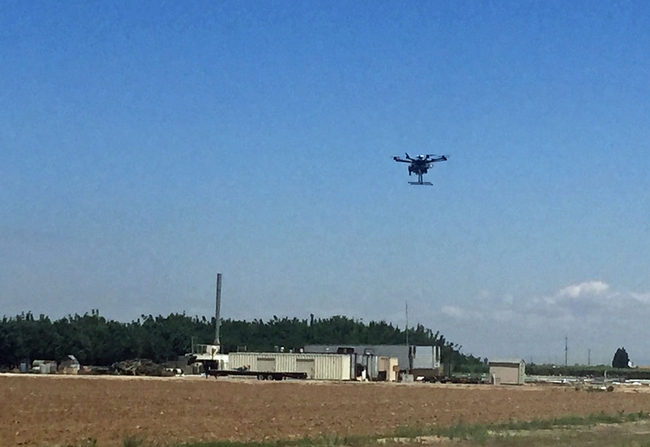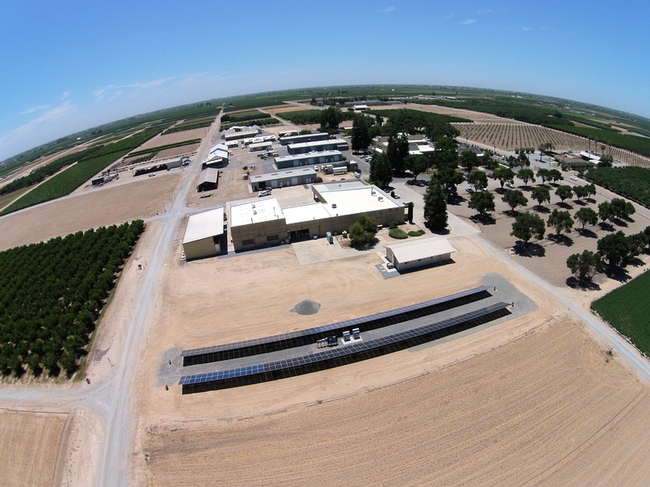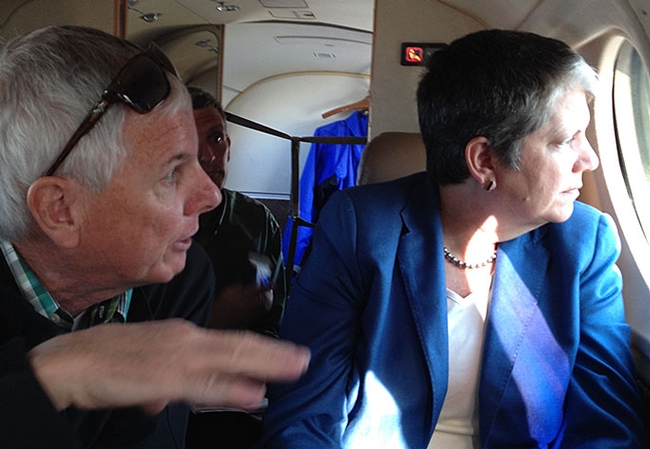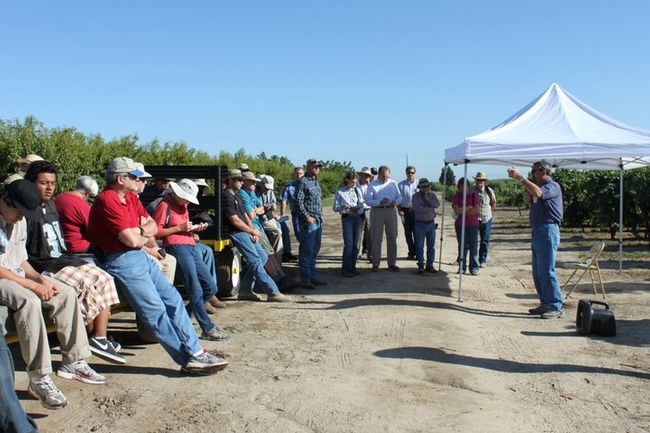Posts Tagged: Kearney
Drone technology on display at UC research center
The UC Desert Research and Extension Center hosted a workshop for employees and local stakeholders on potential uses for drone technology in agriculture, reported Edwin Delgado in the Imperial Valley Press.
“The intent of this workshop is to start bringing the knowledge about unmanned aerial systems to the University of California Agricultural and Natural Resources division and the public at large,” said Sean Hogan, coordinator of Informatics Geographic Information Systems for UC ANR. “There is so much curiosity about it right now, it's a growing industry and there is a lot of concern and controversy about the misuses on it.”
The article said the UC system now has the green light to begin using drones. Hogan is holding workshops throughout the state to share his expertise with UC ANR employees and members of the community.
Desert Research and Extension Center director Jairo Diaz said the workshop was important because participants were able to see a demonstration of how the technology works and how it can be applied to the projects and research they are currently working on.
“These workshops that give growers and stakeholders can use in the area are very important because tech like this can help in the near future help find out different types of issues on the field like management of nutrients, water and find out to improve management of field,” Diaz said.
At the UC Kearney Agricultural Research and Extension Center last week, technicians tested a drone that will be used throughout the summer to collect growth data on 600 varieties of sorghum begin produced under different irrigation regimens. With imaging and lidar, the drone collects information on leaf area and biomass in half an hour that would take a full day for a person in the field.
Read more about the sorghum research at Kearney here.
Phase 3 complete in Kearney solar energy project
JKB Energy has completed three phases of a solar energy project at UC ANR Kearney Agricultural Research and Extension (KARE) Center in Parlier. The system eliminates thousands of pounds of emissions and saves the center tens of thousands of dollars in energy costs annually, according to a JKB Energy news release. Kearney is one of nine research and extension centers located throughout the state that are part of the University of California Division of Agricultural and Natural Resources (UC ANR).
JKB Energy has worked with Robert Ray, superintendent of the UC ANR KARE physical plant, to maximize their bill offset program. Since 2012, when the program started, UC ANR KARE has steadily cut its energy costs.
After the completion of the final phase, projected for 2016, the center's “postharvest” meter's annual electricity costs will be offset by approximately 96 percent. Postharvest research is science conducted after a crop has been harvested and includes such processes as of cooling, cleaning, sorting, and packaging and how these might affect the quality of stored fruits and vegetables.
According to JKB Energy, over 25 years, this project will eliminate the equivalent of:
- 473,735 pounds of carbon dioxide, the leading greenhouse gas
- 1,520 pounds of nitrogen dioxide, which creates smog
- 1,376 pounds of sulfur dioxide, which causes acid rain
- 94 pounds of particulates that cause asthma
- 770,814 miles driven in an average car
The system is the equivalent of taking 2.5 cars off the road for 25 years, or planting 4.1 acres of trees.
UC president Janet Napolitano visits Kearney REC
On her way to Kearney, Napolitano viewed California cropland, rivers and reservoirs that have been impacted by three years of drought.
"There are areas that clearly are being allowed to remain fallow due to drought, there are hills that should be green that are brown, and there are reservoirs where you can clearly see the water mark," she said. "Through the extension service we will work with growers throughout the state to manage this the best way possible."
Ryan Jacobsen, Fresno County Farm Bureau executive director, said growers' relationship with the UC's extension field offices has historically played a big role in the success of the Valley's agricultural economy, Furfaro reported. Advances made in the lab quickly make it to the farms, he said, in large part because of how well regional centers work with farmers.
Alec Rosenberg of the UC Newsroom filed a detailed account of President Napolitano's visit to the San Joaquin Valley. The article said she met with the President's Advisory Commission on Agriculture and Natural Resources to discuss how to engage all 10 campuses in making UC the "go-to" institution in the world for all issues related to food, including sustainability and nutrition.
Napolitano toured the Kearney REC, where she learned about UC's role in helping establish a blueberry industry in the San Joaquin Valley, efforts to preserve the safety of pistachios and other nut crops, and work underway in the center's mosquito lab.
Napolitano noted that she recently made ANR vice president Barbara Allen-Diaz a direct report to her because agricultural issues matter to California and the world, Rosenberg reported.
“It's great to see the incredible depth and breadth of California agriculture, and show the link between UC research and extension and the development of agriculture in the state,” said Allen-Diaz, who accompanied Napolitano on the tour.
Additional coverage:
Napolitano, UC's Kearney center focus on drought relief
Benjamin Genta, UCLA Daily Bruin
'Great Day' morning program features UC Kearney Ag REC
The popular morning television program "Great Day," which airs daily on KMPH Channel 26 in Fresno, featured the work of scientists at the UC Kearney Agricultural Research and Extension Center in six live segments during the five-hour program this morning.
Reporter Clayton Clark and photographer Ryan Hudgins arrived at the Kearney greenhouse at 4:30 a.m. to interview the scientists helping California farmers feed the nation and world sustainably.
See clips of the interviews in the one-minute video below:
Segments included:
- An overview of research and extension activities at Kearney by director Jeff Dahlberg.
- UC blueberry and blackberry research that has made these commodities important crops in the San Joaquin Valley with Manuel Jimenez, UC Cooperative Extension farm advisor in Tulare County.
- Beneficial insects, pests and invasive species that are part of research by Kent Daane, UCCE specialist in the Department of Environmental Science and Policy Management at UC Berkeley. Daane shared a handful of leaf-footed bugs with the reporter.
- How global information systems are changing the way farmers and researchers are looking at farmings systems with Kris Lynn-Patterson, coordinator of the GIS program at Kearney.
- Just like people, plants get sick. UC plant pathologist Themis Michailides explained research efforts to cure plant diseases.
- Uncommon wine varieties that might lead to new fine wines ideally suited to be produced in the Valley's warm climate, with Matt Fidelibus, UCCE specialist in the Department of Viticulture and Enology at UC Davis.
- The very real threat of West Nile virus in mosquitoes in the valley, with medical entomologist Anton Cornel.
Kearney trial could reveal the next great white wine
San Francisco Chronicle wine columnist Jon Bonné wrote about the prospects for another variety of white wine to rise in popularity, perhaps to the level of such well known wines as Chardonnay, Sauvignon Blanc, Pinot Gris and Reisling. In the article, Bonné referenced a new trial at UC Kearney Agricultural Research and Extension Center, where 55 varieties are under study, from Trebbiano to Petit Manseng. The study was designed to determine what might best match the San Joaquin Valley's hot climes. Project leader UC Cooperative Extension viticulture specialist Jim Wolpert was intrigued by grapes from warm spots like Sicily, where Grillo and Carricante thrived in the heat. At the same time, he saw a flood of new varieties being made available by Davis' Foundation Plant Services, yet little interest from nurseries. An experiment was born. "I think there's a treasure trove of varieties there," Wolpert said. "All we need to find is a couple."
Proposed Green Tech High School Academy draws critics
Jennifer Bonnett, Lodi News Sentinel
Lodi Unified School District has proposed developing a Green Tech High School Academy, the first of its kind in California. The district has already spent hundreds of hours and thousands of dollars laying the groundwork for a new school that some trustees say they can’t support. Parent Paul Verdegaal called it the wrong idea at the wrong time. “It appears that LUSD is once again chasing pipe dreams at great cost in money and opportunities for students to actually learn, especially with reduced budgets," he said. The article noted that Verdegaal is a farm adviser for the University of California Cooperative Extension in San Joaquin County. Verdegaal said he sees students who don’t understand science or math, key subjects in creating sustainable practices.
This year's olive harvest is the pits
Martin Espinoza, The Press Democrat
Sonoma County olive growers are bracing for a disastrous harvest, one that could wipe out the supply of fresh local olive oil. Paul Vossen, a farm advisor with the University of California Cooperative Extension, said that in an average low-yield year olive orchards produce 50 to 60 percent less. “We have some places where they have almost nothing,” he said.




